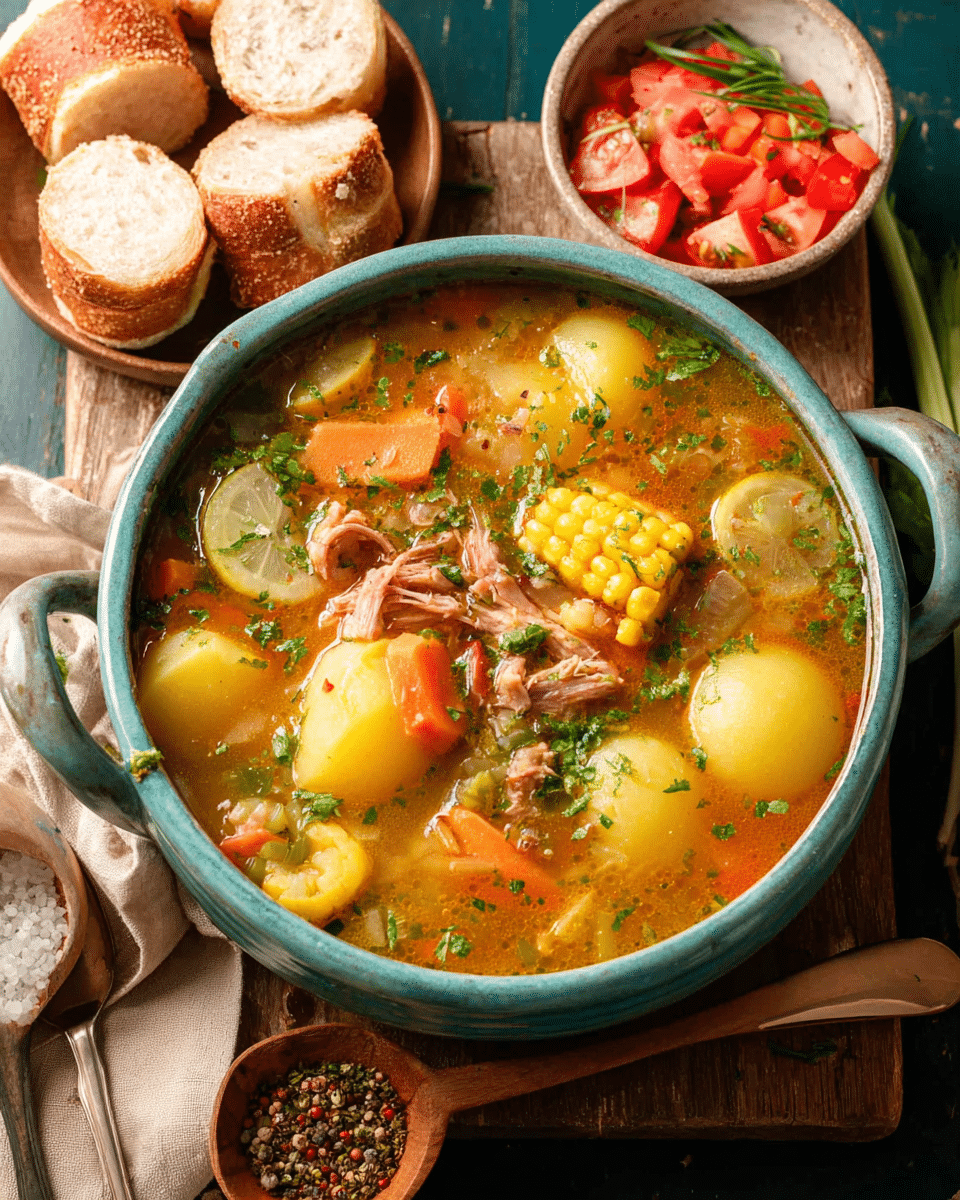Cuban Ajiaco is a soul-warming soup that brings together the rich flavors of slow simmered meats and the earthy sweetness of tropical root vegetables. Each spoonful delivers a perfect balance of tender pork, beef, and ham mingled with pumpkin, plantains, corn, and other hearty produce creating a broth that’s as nourishing as it is flavorful.
This traditional dish is more than just a meal; it’s a celebration of Cuban heritage and the comfort of home cooking. Perfect for cold days or festive gatherings, it invites you to slow down, savor the aroma, and enjoy the deep layers of flavor that only a lovingly prepared, slow-cooked soup can offer. Serve it alongside white rice or crusty bread to soak up every drop of the golden broth.
Full Recipe:
Ingredients:
-
1 tablespoon extra virgin olive oil
-
1 medium onion, small dice
-
1 carrot, diced
-
3–4 garlic cloves, minced or grated
-
2 teaspoons salt, divided
-
1 teaspoon dried oregano
-
¼ teaspoon cumin
-
¼ teaspoon black pepper
-
1 pound smoked ham hocks or ham shank, sliced if available
-
½ pound flank steak, cut into bite-sized cubes
-
½ pound pork stew meat, cut into bite-sized cubes
-
1 (14.5-ounce) can diced tomatoes, drained
-
12 cups water
-
1 green plantain, peeled and cut into ½-inch rounds
-
1 malanga, peeled and cut into 1-inch pieces
-
1 yuca (8–12 ounces), peeled and cut into 1-inch pieces
-
1½ corn cobs, cut into 8–12 thin rounds
-
1 medium boniato (8 ounces), peeled and cut into 1-inch pieces (keep in cold water)
-
1 pound pumpkin, peeled and cut into 1-inch pieces
-
1 semi-ripe plantain, peeled and cut into ½-inch rounds
Directions:
-
Heat olive oil in a large, heavy-bottom pot (at least 8 quarts) over medium heat. Add onions and carrots; cook for 3 minutes, stirring frequently.
-
Add garlic, 1 teaspoon salt, oregano, cumin, and black pepper; cook for 1 minute, stirring often.
-
Stir in ham shank, flank steak, pork stew meat, and remaining 1 teaspoon salt. Cook 2–3 minutes to lightly brown.
-
Add drained tomatoes and stir well. Pour in water, raise heat to high, bring to a boil, then reduce to medium-low. Cover and simmer 60 minutes, stirring occasionally.
-
While simmering, prep vegetables in two batches: Batch One (green plantain, malanga, yuca) together in one bowl. Batch Two (corn, boniato, pumpkin, semi-ripe plantain) with boniato kept in cold water.
-
After 1 hour, remove ham shank to cool. Add Batch One vegetables to soup, bring to a boil, then simmer 30 minutes covered, stirring occasionally.
-
Shred ham meat, discarding fat and bones, and return it to the pot. Add Batch Two vegetables, bring to a boil again, then simmer covered for 30 minutes or until all vegetables are tender.
-
Taste and adjust salt as needed. Serve hot with crusty bread or white rice.
Prep Time: 30 minutes | Cooking Time: 2 hours | Total Time: 2 hours 30 minutes
Kcal: 509 kcal | Servings: 8 servings
Cuban Ajiaco – A Bowl of Heritage and Heart
Few dishes capture the soul of Cuban home cooking quite like Ajiaco. This vibrant, hearty soup is more than a collection of meats and vegetables simmered together; it is a culinary journey that connects generations, celebrates the island’s agricultural bounty, and embodies the slow-food tradition of “cocinar con amor” cooking with love.
While Ajiaco exists in several Latin American countries, the Cuban version stands out for its rich blend of meats and an impressive medley of tropical root vegetables. It is as much a celebration of the harvest as it is a comfort dish for gatherings. Every bite offers layers of flavor that unfold slowly the savory depth of smoked ham, the tender succulence of beef and pork, and the earthy sweetness of root vegetables like malanga, yuca, and boniato.
The Story Behind Cuban Ajiaco
Ajiaco has a long history that reflects Cuba’s diverse cultural influences. While the exact origin is debated, culinary historians trace the Cuban version back to the island’s early colonial era, where Spanish settlers, African culinary traditions, and native Taíno ingredients merged to create something uniquely Cuban.
Originally, Ajiaco was a practical dish a way to use whatever meats and root vegetables were available, stretching them into a filling meal that could feed a large family or an entire work crew. It was commonly prepared for big occasions, festivals, or simply as a hearty meal at the end of a long day. Over time, it became a symbol of abundance and unity, often prepared when family and friends came together.
A Symphony of Flavors and Textures
What makes Cuban Ajiaco unforgettable is its balance of flavors and textures. The broth starts with a savory foundation of meat and aromatics, layered with the smokiness of ham and the richness of beef and pork. As the soup simmers, root vegetables release their starches, naturally thickening the broth and giving it a velvety mouthfeel.
The vegetables in Ajiaco are as much about texture as taste. Malanga offers a nutty creaminess, yuca brings a mild sweetness with a pleasant chew, and boniato (a white-fleshed sweet potato) adds subtle earthy notes. Pumpkin dissolves slightly into the broth, enriching its body, while plantains both green and semi-ripe contribute contrasting flavors, from starchy and firm to sweet and soft. Corn rounds out the ensemble with its bursts of natural sweetness.
Each bite is a combination of tender meat, soft yet distinct vegetables, and the aromatic, herb-laced broth that binds everything together.
Cultural Significance in Cuba
In Cuba, food is often tied to memory, family, and celebration and Ajiaco is a perfect example. It is a communal dish, both in preparation and enjoyment. Making Ajiaco is a slow process, requiring patience and attention, but it’s rarely made in isolation. Relatives and neighbors often join in, peeling vegetables, cutting meat, and sharing stories in the kitchen.
This dish often appears at special occasions, particularly during cooler months when a steaming pot of soup offers warmth and comfort. In rural areas, it has historically been served after harvests, using the fresh bounty of the fields. In Havana and other urban areas, it remains a beloved home-cooked meal, even if ingredients like malanga or boniato might require a trip to a specialty market.
Variations of Cuban Ajiaco
While the core concept of Cuban Ajiaco is fairly consistent, home cooks often put their own spin on the dish depending on availability, personal taste, and regional preferences.
-
With Tasajo: Traditionally, some Cuban Ajiaco recipes include tasajo a type of salted and dried beef that adds a distinctive flavor after being rehydrated. Modern cooks sometimes skip it in favor of more accessible smoked ham hocks or shanks.
-
All-Meat Versions: In certain households, the vegetable medley is reduced, and more emphasis is placed on the meats, making it a heartier, meat-forward stew.
-
Vegetable-Heavy Versions: In other cases, especially in rural kitchens, Ajiaco is packed with even more tropical vegetables, making the dish almost vegetarian if the meat is kept to a minimum.
-
Broth Style: Some prefer a thicker, more stew-like Ajiaco, while others aim for a soupier consistency with a lighter broth.
The flexibility of Ajiaco is part of its charm you can adapt it to what you have on hand without losing its essence.
Serving Suggestions
Cuban Ajiaco is a complete meal in itself, but in true Cuban style, it is often served with a side of white rice. The rice acts as a perfect backdrop, soaking up the flavorful broth. Crusty bread is another popular accompaniment, especially for dipping into the soup.
For a more traditional experience, serve Ajiaco in deep bowls with generous chunks of both meat and vegetables. Garnishing isn’t typical for Cuban home cooking, but a sprinkle of fresh cilantro or parsley can add a nice touch for presentation.
A side salad of crisp greens with a light vinaigrette can balance the richness of the soup, and if you want to offer a beverage pairing, a cold glass of malt beverage or fresh tropical juice (like guava or mango) complements the hearty flavors.
Storing and Reheating
One of the best things about Ajiaco is that it tastes even better the next day. As it rests, the flavors meld and deepen. In the refrigerator, Ajiaco will keep well for up to 3–4 days when stored in an airtight container. The soup can also be frozen for up to two months just remember to leave a bit of space in the container to allow for expansion.
When reheating, do so gently over medium heat to preserve the texture of the vegetables. If the broth thickens too much during storage, a splash of water or broth will bring it back to the right consistency.
Why This Dish Stands Out
In the world of Cuban cooking, there are many beloved soups and stews from potaje de lentejas (lentil stew) to sopa de chicharos (split pea soup). Yet, Ajiaco occupies a special place because of its abundance. It’s not a dish made with one or two vegetables; it’s an orchestra of flavors and textures that reflects Cuba’s agricultural richness and culinary heritage.
Moreover, Ajiaco is as much about the process as the end result. It teaches patience, encourages sharing, and rewards the cook with a meal that’s as satisfying to make as it is to eat.
Conclusion:
Cuban Ajiaco is more than a recipe it’s a living tradition. It speaks of resourcefulness, cultural blending, and the joy of gathering around the table. Whether you prepare it for a holiday, a family reunion, or simply to warm up a cool evening, Ajiaco brings comfort and connection with every serving.
Its long simmering time and generous ingredient list might seem daunting at first, but the result is well worth it: a pot full of nourishing broth, tender meats, and vegetables so flavorful you’ll savor every spoonful. And, like all great comfort foods, it invites conversation, laughter, and the kind of shared moments that make meals truly memorable.
For those exploring Cuban cuisine, Ajiaco is an essential dish to experience one that showcases the heart of the island’s food culture in the most delicious way possible.






